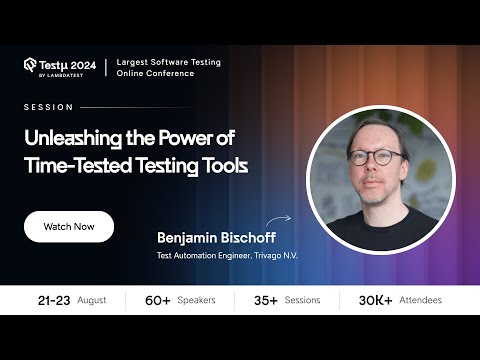 Discover how blending classic and new testing tools can bridge knowledge gaps, inspire deeper exploration of familiar technologies, enhance efficiency, reduce errors, and elevate quality.
Discover how blending classic and new testing tools can bridge knowledge gaps, inspire deeper exploration of familiar technologies, enhance efficiency, reduce errors, and elevate quality.
 Don’t miss out—register now and join us live
Don’t miss out—register now and join us live 
Got questions? Drop them below and get them answered during the session! 
Hi there,
If you couldn’t catch the session live, don’t worry! You can watch the recording here:
Here are some of the Q&As from this session:
How can teams maximize the value of time-tested tools while incorporating them into agile or DevOps workflows?
Benjamin: Teams can maximize the value of time-tested tools by integrating them into agile or DevOps workflows through continuous integration/continuous deployment (CI/CD) pipelines. Ensure these tools are compatible with modern development practices and automate their usage where possible. Leverage plugins or adapters that allow legacy tools to work seamlessly within agile frameworks, and regularly update the tools to address any compatibility issues.
What are some creative ways to extend the functionality of legacy testing tools to handle modern applications and architectures?
Benjamin: Extend legacy tools by using middleware or custom scripts to bridge gaps between the old and new systems. Integrate with modern APIs and services to enhance functionality. Consider using wrappers or adapters that allow legacy tools to interact with contemporary technologies and frameworks. Additionally, incorporate modern reporting and analytics features to enhance the tool’s capabilities.
How have traditional testing tools evolved to meet modern testing needs?
Benjamin: Traditional testing tools have evolved by incorporating support for new technologies and methodologies. Many have added features for automated testing, continuous integration, and cloud-based testing. They now support a wider range of platforms, including mobile and web applications, and offer enhanced reporting and analytics capabilities. Some have also integrated with modern development tools and frameworks to keep pace with evolving practices.
What are the best practices for integrating older tools into contemporary testing environments?
Benjamin: Best practices include assessing compatibility with current technologies, using APIs or connectors to facilitate integration, and automating workflows to streamline processes. Regularly update and maintain these tools to ensure they continue to meet current requirements. Provide training for team members to effectively use both old and new tools in harmony.
Now, let’s see some of the unanswered questions!
How might the role of older testing tools evolve with emerging technologies and practices?
What future trends should be considered when deciding whether to keep or replace legacy tools?
How can you optimize the performance of older testing tools to keep them relevant and efficient?
How can legacy testing tools be adapted to support modern software development methodologies like Agile and DevOps?
What are the key components of a resilient QA team culture, and how can leaders foster these elements to ensure long-term success and stability?
What resources would you recommend for testers to explore to discover great proven tips and tools they can use?
What are some effective methods for combining classic and new testing tools to reduce knowledge gaps and make more informed decisions?
How do tools like Selenium, GNU Make, Maven, and Bash still hold up in today’s testing environment, and what are some practical examples of their continued relevance and effectiveness?
How to integrate AI or other tools with legacy tools to make sure no major changes ?
Do think in future the code based automation tools will loose its relevance ?
What older but proven open-source testing tools would you recommend?
How to integrate legacy tech tools with latest trends ?
What is something old that’s a must know for us QA ?
How do the user experiences and learning curves of traditional tools compare to modern testing tools, and what impact does this have on team productivity?
![]() Discover how blending classic and new testing tools can bridge knowledge gaps, inspire deeper exploration of familiar technologies, enhance efficiency, reduce errors, and elevate quality.
Discover how blending classic and new testing tools can bridge knowledge gaps, inspire deeper exploration of familiar technologies, enhance efficiency, reduce errors, and elevate quality.![]() Don’t miss out—register now and join us live
Don’t miss out—register now and join us live ![]()
![]()

